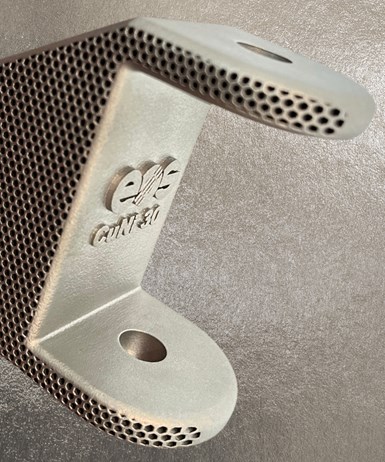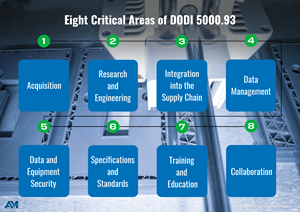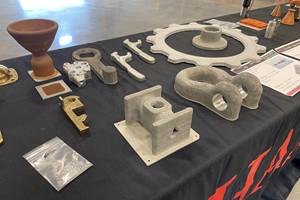EOS Works With Phillips Federal, Austal USA to Develop CopperAlloy CuNi30 for US Navy Submarine Industrial Base
Using the copper-nickel alloy in combination with EOS’ platforms offers new design and production capabilities for U.S. Navy submarines, while also enabling the agency to limit global supply chain disruption because parts can be produced regionally, locally and on-demand.
(left to right) Admiral Scott Pappano; President of Phillips Corp. Alan Phillips; Secretary of the Navy, Carlos Del Toro; Sr. Vice President Global Additive John Harrison. Source: Phillips Corp.
Working with Phillips Federal and Austal USA, EOS has developed a copper-nickel (CuNi) material for the U.S. Navy Submarine Industrial Base (SIB) to mitigate casting supply chain delays. The material was tested and developed to meet the goal of “2+1 Columbia and Virginia Class submarine platforms” for the U.S. Navy.
The copper-nickel alloy meets UNS C96400 specifications and was engineered specifically for laser powder bed fusion (LPBF) industrial additive manufacturing (AM). It is well suited for the marine, energy and chemical industries, providing excellent corrosion resistance in salt water and sustained performance in low temperatures.
The CuNi30 material was developed and tested to alleviate the supply pressure of traditional castings. Source: EOS
The material in combination with EOS’ platforms offers new design and production capabilities for U.S. Navy submarines, while also enabling the agency to curb global supply chain disruption because parts can be produced regionally, locally and on-demand. The material is now available commercially.
EOS CopperAlloy CuNi30 delivers excellent performance and material properties with a combination of high strength and ductility, around 510 MPa UTS and more than 20% elongation. The material achieves excellent corrosion resistance in salt water and sustained performance in low temperatures. With these mechanical properties, EOS has successfully met UNS C96400 specifications as mentioned in ASTM B369-09 for mechanical performance.
The CuNi30 material was developed and tested to alleviate the supply pressure of traditional castings and meet the goal of “2+1 Columbia and Virginia Class submarine platforms” for the U.S. Navy. Phillips Federal notes that the material’s exceptional performance combined with the competitive cost-per-part (CPP) has created a strong business case for production implementation.
“EOS was provided with a strategic objective to deliver a CuNi30 product to the U.S. Navy submarine industrial base to mitigate casting delays; a material holding unique to the naval construction industry and not widely available for AM technology use,” says Dr. Ankit Saharan, senior manager of metals technology at EOS. “We acted with priority to support the submarine program schedule, and we are pleased to share our successful product release within a few months of the project start. It is a privilege to contribute to projects of such strategic importance to our national interests.”
Supply Chain Efficiencies, Accelerated Lead Times and Reduced Inventories
Traditionally, manufacturing of CuNi alloy applications is done by casting and can be costly due to testing and quality requirements. There is also a lack of suppliers who can meet the application requirements. With the combination of EOS CopperAlloy CuNi30 and the quality and productivity of EOS platforms, these applications can now meet both requirements, while also opening new design and production capabilities industrial 3D printing affords manufacturers. The fact that parts can now be produced regionally, locally and on-demand is another huge advantage.
“We are grateful for the response from EOS and the Additive Minds team to develop EOS CopperAlloy CuNi30 so quickly,” says John Harrison, senior vice president of global additive at Phillips Federal. “This alloy is critical in many marine applications and will be important in our efforts to support the U.S. Navy Center of Excellence.”
EOS CopperAlloy CuNi30 is now commercially available for the midframe EOS M 290 and the large frame EOS M 400, followed by the four-laser EOS M 400-4 later in 2024.
Related Content
The Cold Spray Solution to the Casting, Forging Supply Chains
Startup HAMR Industries performs additive manufacturing work at Neighborhood 91 that provides an alternative to traditional casting and forging. Success so far has led to redefining the limits of its additive equipment.
Read MoreDOD Drives Transformation with New AM Policy
The U.S. Department of Defense published DODI 5000.93, a comprehensive plan for implementing additive manufacturing among military services.
Read More3D Printed Replacement Clamp for an F-16 Aircraft: The Cool Parts Show #54
3D printing is a valuable addition to sustainment programs, but only if printed parts can be qualified as fast and flexibly as they can be made. In this episode of The Cool Parts Show, we look at the clamp that won the Air Force’s Approval Sprint Challenge designed to address this need.
Read MoreNeighborhood 91 Expands, With Metal Powder Works and HAMR Now Open
Ribbon cuttings for the Pittsburgh campus's newest tenants coincided with the announcement that a DOD-funded resilient manufacturing program will also be developed at the site.
Read MoreRead Next
At General Atomics, Do Unmanned Aerial Systems Reveal the Future of Aircraft Manufacturing?
The maker of the Predator and SkyGuardian remote aircraft can implement additive manufacturing more rapidly and widely than the makers of other types of planes. The role of 3D printing in current and future UAS components hints at how far AM can go to save cost and time in aircraft production and design.
Read More3D Printing Brings Sustainability, Accessibility to Glass Manufacturing
Australian startup Maple Glass Printing has developed a process for extruding glass into artwork, lab implements and architectural elements. Along the way, the company has also found more efficient ways of recycling this material.
Read MoreHybrid Additive Manufacturing Machine Tools Continue to Make Gains (Includes Video)
The hybrid machine tool is an idea that continues to advance. Two important developments of recent years expand the possibilities for this platform.
Read More























